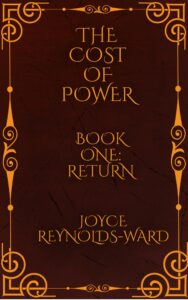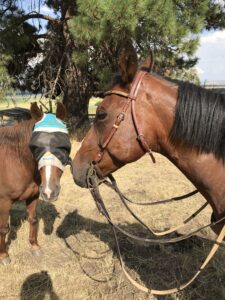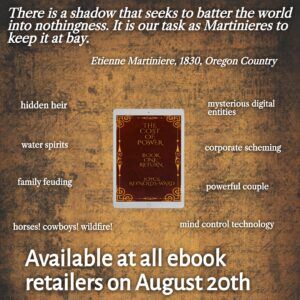I learn something new from every book I write, even after twenty-five odd books out there.
Sometimes what I learn is a writing craft detail. Other times it’s a production or promotion detail.
I’ve learned a lot from the last four years of writing the assorted Martiniere Family Saga books. But I had several explicit reasons for working on The Cost of Power. First, I wanted to finish some loose ends left in the other series, most explicitly the hints at a multiverse and how that works. Second, well, I’ve written about taking a villain and turning him (Philip Martiniere) into a more shades-of-gray protagonist capable of redemption. Philip can still be a jerk, but he’s not the irrationally sociopathic character he was in the other Martiniere books. In some aspects, The Cost of Power is in part Philip’s redemption story.
Also, I decided that there was one big universe story left in this book world, and that I could accomplish what I wanted to learn best with familiar characters. A writing exercise, you might say, where I could focus on my story goals.
The most important piece, however? For the first time, I mindfully sat down to write an entire series–in this case a trilogy–before publishing it.
Why would I want to do that? Well, for one thing, I’ve learned in my years of writing that I have this…ahem…tendency to throw completely new notions into a series about two-thirds of the way through. I did it with Goddess’s Honor and with the Netwalk Sequence. The first Martiniere Legacy series was somewhat of an attempt to write a series but the fourth book really threw things into a whiplash. Not only that, I didn’t originally conceive of the books in this manner, and really didn’t have a coherent series arc. Oh, I fixed it in rewrites but there was a lot of pain and agony in the process. I wanted to cut back on the agony.
How best to change this, especially since I wanted a flexible structure to reflect inevitable diversions from the original plan?
First, I roughly devised book and series arcs. I knew what the endings were more or less going to be for each book, and how the series was going to wrap up. I wrote chapter synopses for each book.
Then I turned to Scrivener as an organizing tool. I’m not fond of drafting in that program, but it’s a great place to keep my research notes as well as a chapter-by-chapter version of the work in progress. I drafted chapters in Word, then pasted them into Scriv. That served a couple of purposes. First, if I wanted to look something up, instead of searching or scrolling an entire document, I could look at the chapter or synopsis to find the information. Second, this allowed me to establish the Scrivener version as the definitive first draft. I did corrections and edits in Scriv. Finally, I had my research and character notes as well as the synopsis under Scrivener’s Research tab.
When I revised the synopsis, I used strikethrough to eliminate the old stuff without deleting, just in case I needed to recover it or place that concept in a different chapter. If I wanted to look at my original draft, I could pull up the chapter file from Word. I didn’t have to mess with complex versioning methods while in that particular book. When I came up with outtakes and snippets that helped me understand a particular character or scene, I stuffed it in its own file under Research in Scriv (about the only time I drafted in Scrivener).
That’s just the drafting lessons I learned this time around.
Production issues–as always, I learned little things about details. Today I got annoyed when I learned that I have to produce an entirely different-sized cover if I want to produce a paperback in Amazon as well as Ingram. Um, I’ll stick with Ingram. It’s just a tiny difference in size because Amazon produces thicker covers, but I’ve heard enough quality and packaging complaints about the ‘Zon that I’m not gonna go into the hassle of making a different cover entirely, just over fractions of sizes (I make my covers in BookBrush). Plus if I decide to go with a cover artist, I’m not paying for TWO different paperback covers. Nuh-uh.
I’m also going to have to do some different things when it comes to saving file structures as well, because my files are a mess that desperate needs fixing. Well, that will be the next project.
Meanwhile?
The Cost of Power is out there in the world. Return and Crucible are available at all ebook retailers, and Redemption comes out on September 10th. The Return paperback is now available. Crucible will be available soon, and Redemption as well. I…um…made a mistake when loading Crucible and didn’t put it on preorder with one vendor. That threw off the release timeline.
Linking to the Amazon series page here for convenience–it’s also available on Apple, Kobo, Barnes and Noble, and Smashwords.
And, as always, if you want to help me keep the horses happy with a cookie or two, you can contribute to the Poor Cookie-Deprived Horses Fund here.
(note: they aren’t really Cookie-Deprived, much as they will claim otherwise.)




